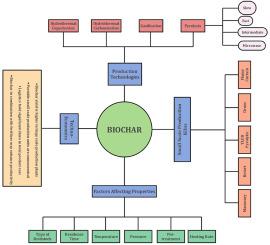木质纤维素生物质转化为生物炭:生产技术对生物炭产量和技术经济的影响综述
IF 6.2
2区 工程技术
Q2 ENERGY & FUELS
引用次数: 0
摘要
生物炭技术由于其在去除废水中的污染物、作为超级电容器储存能量、增强土壤健康以及作为负排放技术解决环境挑战方面的多方面潜力而受到全球的关注。本研究的目的是回顾利用各种热化学转化方法将不同类型的木质纤维素生物质转化为生物炭。综述了采用不同表征技术制备的生物炭的理化性质。与主要生产生物油或合成气的快速热解、气化或快速碳化相比,缓慢热解始终能产生更高的生物炭产量(高达约79%)。较小的生物质颗粒增强了传热,并且可能由于加速热解过程而导致产量降低。较低的温度和富含木质素的生物质促进更高的固体产量,而较高的温度促进碳化,但导致生物炭产量降低。此外,根据现有文献,报告了大规模工业单位和小规模便携式系统生产生物炭的经济可行性,并且发现小规模单位生产生物炭的销售价格更高。生物炭技术面临的主要挑战包括但不限于先进的收获技术、改进的物流、分散的高效经济的生物炭生产装置、生物炭添加到土壤中的方法等。该技术的未来研究应侧重于为特定应用定制生物炭特性,优化热解条件和后处理技术,并探索替代原料以提高可持续性、效率和多功能性。本文章由计算机程序翻译,如有差异,请以英文原文为准。

Lignocellulosic biomass to biochar: An overview on impact of production technologies on biochar yield and techno-economics
Biochar technology is getting attention globally due to its multifaceted potential in removing contaminants from wastewater, storing energy as supercapacitor, enhancing soil health, and addressing environmental challenges as a negative emission technology. The aim of this study is to review the conversion of different types of lignocellulosic biomass into biochar using various thermochemical conversion methods. The physiochemical properties of produced biochar using different characterization techniques have been reviewed. Slow pyrolysis consistently produces higher biochar yields (up to approximately 79 %) compared to fast pyrolysis, gasification, or flash carbonization, which primarily focus on generating bio-oil or syngas. Smaller biomass particles enhance heat transfer, and may lead to reduced yields due to the accelerated pyrolysis process. Lower temperatures and lignin-rich biomass promote higher solid yields, whereas higher temperatures facilitate carbonization but result in reduced biochar yield. Further, the economic viability of biochar production from large-scale industrial units and small-scale portable systems is reported as per the existing literature and the selling price of biochar produced from small scale units is found to be higher. This review suggested that the major challenges in biochar technology include but not limited to advanced harvesting techniques, improved logistics, decentralized efficient and economical biochar production units, method of biochar addition to soil etc. Future research in this technology should focus on tailoring biochar properties for specific applications, optimizing pyrolysis conditions and post-processing techniques, and exploring alternative feedstocks to enhance sustainability, efficiency, and versatility.
求助全文
通过发布文献求助,成功后即可免费获取论文全文。
去求助
来源期刊

Journal of The Energy Institute
工程技术-能源与燃料
CiteScore
10.60
自引率
5.30%
发文量
166
审稿时长
16 days
期刊介绍:
The Journal of the Energy Institute provides peer reviewed coverage of original high quality research on energy, engineering and technology.The coverage is broad and the main areas of interest include:
Combustion engineering and associated technologies; process heating; power generation; engines and propulsion; emissions and environmental pollution control; clean coal technologies; carbon abatement technologies
Emissions and environmental pollution control; safety and hazards;
Clean coal technologies; carbon abatement technologies, including carbon capture and storage, CCS;
Petroleum engineering and fuel quality, including storage and transport
Alternative energy sources; biomass utilisation and biomass conversion technologies; energy from waste, incineration and recycling
Energy conversion, energy recovery and energy efficiency; space heating, fuel cells, heat pumps and cooling systems
Energy storage
The journal''s coverage reflects changes in energy technology that result from the transition to more efficient energy production and end use together with reduced carbon emission.
 求助内容:
求助内容: 应助结果提醒方式:
应助结果提醒方式:


